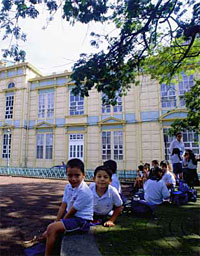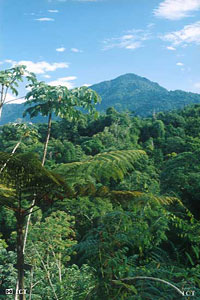
Explorations
|
San Jose
 San Jose has the infamous reputation as the ugly duckling of Central America. It is a
hectic city of over 1.5 million, swamped with traffic, crowds, and noise. Very few of the
architectural draws belonging to other capitals along the isthmus exist in San Jose.
Behind the drab exterior, however, the city is the best place to meet the people of Costa
Rica. They are famous for their generosity and good humor. The city has some particularly
good museums, most notably the Jade Museum.
San Jose has the infamous reputation as the ugly duckling of Central America. It is a
hectic city of over 1.5 million, swamped with traffic, crowds, and noise. Very few of the
architectural draws belonging to other capitals along the isthmus exist in San Jose.
Behind the drab exterior, however, the city is the best place to meet the people of Costa
Rica. They are famous for their generosity and good humor. The city has some particularly
good museums, most notably the Jade Museum.
Braulio Carrillio National Park
One of Costa Rica's superior parks, Braulio Carrillio's 46,000 acres of rainforest are surrounded by a dramatic stretch of mountain highway connecting San Jose and the coastal city of Limon. Over 6,000 species of trees cling to the park's misty volcanic slopes, providing a lush habitat to more than 500 types of birds and 135 kinds of mammals. Here, you can find the treasured quetzal, a bird of mythic and unsurpassed beauty. As you hike beneath the forest canopy, hundreds of species of butterflies waft past like colorful pixies. Howler monkeys sing out eerily and swing in the net of branches above. The ground vegetation hides pumas, ocelots, tapirs, raccoons, and countless other mammals which are often heard but seldom seen.
One of the park's best features is the Teleferico del Bosque Lluvioso, or rainforest tram. The tram takes visitors on a 90-minute tour through the hidden world of the forest canopy, where two-thirds of all flora and fauna live. It is the only vehicle of its kind in the world and the only way to view the canopy outside of scaling a tree. The tram was constructed with the assistance of the Nicaraguan government, which provided the Russian helicopters that carried in the towers supporting the 1.5 km of cable.
 Poas National Park
Poas National Park
There are only a few places in the world where you can drive up to the edge of an active volcanic crater, and Poas National Park is one of them. There are in fact two craters visible from the summit of the volcano, the largest some 1.5 km wide. Poas is a scene from Dante's Inferno. Hellish exhalations of sulfuric gasses puff from vents a mere 300 meters below the observation platform, and a small lake pours off enraged steam. Surrounding the smaller cone is a dense forested area that is one of the few remaining habitats of the brilliant scarlet macaw. The eruption cycle of the Poas volvano is about forty years, and the last eruption was in 1978. During heightened volcanic activity the park may be closed. Poas is located about 30 miles to northeast of San Jose.
Corcovado National Park
Jungle-hungry adventurers will be pleased with this park. It is one of the largest, most remote, biologically dense, and challenging parks in the country. Its 54,500 hectares are located in the far south on the Osa Peninsula, and there is a great variety of habitat. On the west coast of the peninsula are miles of beaches, while its interior is a dense network of rivers, rain forests, and swamp land. The animal life here is known for its size. Jaguars roam in the shadows of the cloud forest, crocodiles ply the swamp, and hammerhead sharks have been known to cruise the estuaries.
Tortuguero National Park
No place is more vital to the survival of the Caribbean's green sea turtle than Tortuguero National Park. Located on the northern Caribbean coast, the park is home to nearly 30,000 of these marvelous animals---the largest breeding population in the world. Throughout the first half of this century, the turtles were hunted to near extinction for their value as a food source.
Visitors to Tortuguero have the rare privilege of watching the turtles dig their nests on the beach, an impressive and fascinating sight. The height of the nesting season comes in May and June, but at any given time there are usually a few nesting. The park also has extensive waterways leading inland, where more parklands harbor a variety of other animals, including sloths, crocodiles, toucans, monkeys and morpho butterflies.
Talamanca National Park
This tropical forest in the Talamanca mountains is almost perfectly intact. In 1982, UNESCO declared it a biosphere reserve, and then a world patrimony site a year later. Its climate zones, each harboring distinct flora and fauna, begin at 50 meters and rise to a towering 3820 meters. It covers an area of 193,929 hectares, joined to a nearly equal in size reserve on the other side of the Panamanian border.
The Reventazon
White water rafting and kayaking is becoming increasingly popular in Costa Rica. The bountiful rivers and their rapids provide more than just exciting recreation; they are a magnificent way to see the country. Many of them snake through the mountains and rainforests, and water travelers get to participate in the environment they witness. No river offers a more prized experience than the Reventazon, which stretches along the Nicaraguan border then down the Colorado delta system to the Caribbean coast. Rafting trips can be arranged in San Jose.
Copyright (c) 1998-2006 interKnowledge Corp. All rights reserved.
